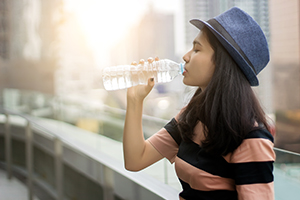Heatstroke Treatment in Van Nuys, CA

Fun in the sun is what summer’s all about, but it’s important to be cautious, as too much heat doesn’t just make you sweat; it can make you hurt. Badly.
Heatstroke—also known as heat stroke or sunstroke—is the overheating due to excessive physical activity, exposure to high temperatures, or both at once. Symptoms of heatstroke include muscle cramps, a throbbing headache, and nausea.
While staying cool and hydrated can help protect you, heatstroke is a serious medical emergency. To find treatment in Van Nuys, call (424) 365-1800 or contact Dr. Jeremy Fischer online.
What Are Symptoms of Heatstroke?
The first sign of heatstroke is heat cramps, which are muscle cramps in the legs or abdomen. Other symptoms of heatstroke include:
- throbbing headache
- dizziness or light-headedness
- lack of sweating in hot weather
- red, hot, and dry skin
- nausea or vomiting
- rapid heartbeat
- rapid, shallow breathing
- staggering
- behavioral changes like confusion
A heat stroke may render you unconscious or cause a seizure. If not treated, heatstroke can cause organs like the brain to swell, and can even be fatal.
What Causes Heatstroke?
During a heatstroke your body temperature reaches greater than 104°F. There are two types:
- classical heat stroke: generally seen in older people during heat waves; takes 2-3 days of heat exposure to develop
- exertional heat stroke: usually affects younger people who are exerting themselves in a hot, humid environment; develops suddenly
You are more likely to get heatstroke if you:
- are a child younger than four years old
- are 65 years old or older
- an athlete
- are dehydrated
- drink too much alcohol or coffee
- are in a place without fans or air conditioning
Any conditions that cause a fever can increase your risk of heat stroke. Other conditions that can increase your risk include:
- heart, lung, or kidney disease
- obesity
- underweight
- high blood pressure
- diabetes
- mental illness
- sickle cell trait
Medications that may increase your chance of heatstroke are:
- antihistamines
- diet pills
- diuretics
- sedatives
- tranquilizers
- stimulants
- seizure medications (anticonvulsants)
- heart and blood pressure medications like beta-blockers
- antidepressants and antipsychotics
- illegal drugs like cocaine
How is Heatstroke Diagnosed and Treated?
While the signs of a heatstroke are usually easy to see, other ways to diagnose sunstroke include:
- rectal temperature: the most accurate way to determine your core body temperature
- blood test: checks blood sodium and potassium levels, and the content of gases to determine if there’s central nervous system damage
- urine test: darker urine is a sign of a heat-related condition
- muscle test: to check for muscle damage (rhabdomyolysis)
- imaging test: to check for organ damage, like in the kidneys and brain
If you or someone you know is showing signs of heatstroke, follow these first aid steps:
- Call 911 immediately
- Move the affected person to a cooler area away from direct sunlight
- Remove as much clothing as possible and place them on their side
- Apply cool, wet cloths or ice packs to the skin, especially the armpits, groin, neck, and back
- If needed, use a cool shower or tub to cool the person down
- If they are awake or alert enough to swallow, give them cool liquids
- Place a person suffering from an exertional heat stroke in an ice bath, unless the victim is a child, a senior citizen, or chronic illness sufferer
Once emergency personnel arrive, they can take over cooling efforts. They may use a cooling blanket or try evaporation cooling techniques (cool water is misted onto your body while warm air is fanned over you). Medication to stop shivering may be used as a treatment for heatstroke, as shivering can raise your body temperature.
There is also research being done on calcitonin gene-related peptide (CGRP), a peptide that plays a role in regulating blood pressure and nerve conduction; studies with rats suggests that that CGRP has a protective effect on early-stage brain injury caused by heatstroke.
If there is no organ damage, most people will recover within 1-2 days in the hospital with little or no problems, though you may become more sensitive to hot weather in the future. Complete recovery from heat stroke and its effects on the internal organs may take 2 months to a year. As with any medical procedure, results will vary depending on your age, genetics, environmental conditions, and other health factors.
How Do You Prevent Heatstroke?
When in hot weather, prevent heatstroke by:
- taking regular breaks in an air-conditioned environment
- staying hydrated; it’s recommended that you drink eight glasses of water per day (24 ounces of fluid two hours before exercise, 8 ounces of water or sports drink right before exercise, and 8 ounces of water every 20 minutes while exercising)
- wearing lightweight, light-colored, loose-fitting clothing, and a wide-brimmed hat
- avoiding outside work during midday; go outside before 10 a.m. and after 3 p.m.
- using sunscreen with a sun protection factor (SPF) of over 30
- not keeping anyone (especially children) in a locked car on a hot day
- avoiding caffeine and alcohol, as they can dehydrate you
- asking your healthcare provider if there are any medications that you’re taking that could increase your risk of heatstroke
Reserve Your Appointment Now
Just like it’s important to wear a coat in the winter, it’s important protect yourself in the summer. Be mindful of your health and the health of those around you and be prepared to perform heatstroke first aid if the emergency arises. To learn more about treating heatstroke in Van Nuys, call (424) 365-1800 or contact Dr. Jeremy Fischer online.
Vitality Integrative Medicine
Address
4849 Van Nuys BlvdSuite 104
Sherman Oaks, CA 91403
(424) 365-1800
www.vitalityintegrative.com
Hours
Mon:
8:00 am - 6:00 pm
Tue:
8:00 am - 6:00 pm
Wed:
8:00 am - 6:00 pm
Thu:
8:00 am - 6:00 pm
Fri:
8:00 am - 6:00 pm
Sat:
8:00 am - 12:00 pm

